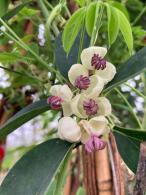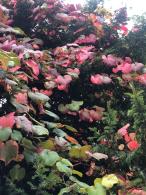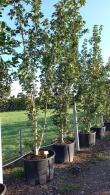Aristolochia Macrophylla Pipevine
1. Add items to basket
2. Go to the basket
3. Enter your postcode in Delivery Price Check
To check delivery cost add your plants to basket, then you can type your postcode in our Quick Delivery Price Check.
Aristolochia Macrophylla or Dutchman's Pipe Climber
The Aristolochia Macrophylla is a native deciduous vine of the Eastern United States and parts of Ontario, Canada. It is commonly referred to as the Dutchman’s Pipe or the Pipevine. It received its unique monikers because of the flowers this climber produces which resemble a meerschaum pipe.
The flowers of the Dutchman’s Pipe are yellowish-green and typically measure approximately 5 centimeters in length. The blossoms appear in profusion in May and persist into August. Each flower of the Aristolochia macrophylla features a heady, unusual fragrance that attracts a bevy of insects to the garden. Once an insect enters the flower it is trapped by the fine hairs located inside the blossom’s throat. The hairs point downward so the insect enters the tunnel easily but then becomes trapped with no avenue of escape as the hairs downward slope works to imprison the insect. The more the insect tries to escape, the more pollen that is rubbed off the insect onto the fine hairs of the bloom to ensure pollination. Interestingly, the insect is not doomed. The bloom secretes a tiny bit of honeydew. It just enough to keep the insect from starving. Once pollination occurs, the flowers stigmas wither and the trapped insect can escape. After pollination, the Pipevine produces a long fruit that resembles a cucumber. It measures 6 to 10 centimeters in length and 3 centimeters across and contains an abundance of seeds.
Even though the vine is famous for its unusual flowers, the truly outstanding feature of the Aristolochia macrophylla is its foliage which is so profuse that it often hides the flowers. Each leaf is heart-shaped and measures 15 to 30 centimeters across and overlaps its neighbouring leaf to create a dense overflow of foliage that is exceptionally eye-catching.
Plant Dutchman’s Pipe vine in full sun for best growth. However, it will tolerate partial shade but may not grow as large. Ideally, when planting the Pipevine, choose a planting location that is well-draining. Keep the soil moist during the first year of growth to encourage a strong root and diverse system to adequately support the large vine. The woody vine grows rapidly to heights of 9 meters or more.
Aristolochia macrophylla grows in a twining fashion. Provide it with a sturdy trellis or arbor to sprawl across. Many people grow it across the facade of a building or house. The Pipevine tolerates pruning well to maintain its size and shape. Prune the vine in the late winter or early spring. Remove no more than one-fourth of the vine at a time or you may stunt its growth. Ideally, trim away the weakest branches of the vine.
Plant the Dutchman’s Pipe vine anywhere that you desire a vigorous vine that requires very little care to thrive. It usually looks outstanding in woodland gardens. The Aristolochia macrophylla vine is also cherished for its ability to attract butterflies to the garden. It is the principle food source of the Pipevine Swallowtail butterfly.













